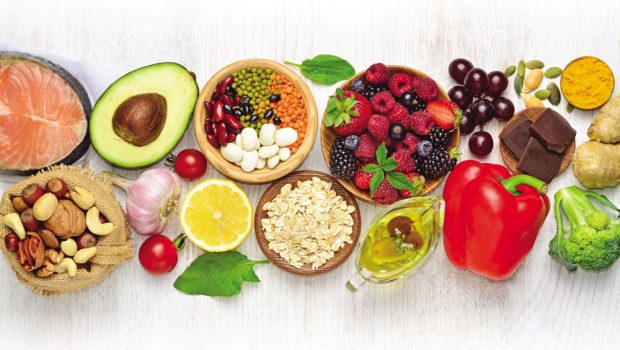NUTRITION UPGRADES
Five Strategies for Better Health
by Melinda Hemmelgarn
Springtime brings a desire to clean up our diets and refresh our plates. Here are five worthy strategies for upgrading nutrition and greeting the season with a renewed sense of well-being.
Ditch dieting.
According to the Boston Medical Center, an estimated 45 million Americans go on a diet each year and spend more than $30 billion annually on weight-loss products. Despite this hefty investment, restrictive diets don’t work, says Sandra Aamodt, a neuroscientist based in northern California. Aamodt co-presented the Neurobiology of Dieting: Evidence for Improving Mental Health With a Self-Care Approach session at the Academy of Nutrition and Dietetics (AND) annual meeting last October in Washington, D.C.
“Diets are not harmless,” Aamodt explains. “They create stress, persistent hunger, trigger eating disorders such as binge eating and even make people fatter over time.”
It’s better to take a kinder approach, says Rebecca Scritchfeld, a Washington, D.C.-based registered dietitian and Aamodt’s co-presenter. Scritchfeld is the author of Body Kindness: Transform Your Health From the Inside Out – and Never Say Diet Again. She teaches her clients to value their self-worth regardless of body size, practice mindful eating and focus on overall self-care: Think enjoyable physical activity, adequate sleep and positive self-talk.
Mindful eating includes paying attention to thoughts and feelings that trigger eating such as hunger, but also stress, boredom and loneliness, says California based registered dietitian Andrea Lieberstein, who wrote Well Nourished: Mindful Practices to Heal Your Relationship with Food, Feed Your Whole Self, and End Overeating. She encourages clients to identify voids in their lives and fill them with healthy relationships and pleasurable activities, rather than food.
The “health at any size” philosophy is accepted by a growing number of health and nutrition experts, including Annie Kay, a registered dietitian and registered yoga therapist at the Kripalu Center for Yoga and Health, in Stockbridge, Massachusetts. She’s the author of Every Bite is Divine: Te Balanced Approach to Enjoying Eating, Feeling Healthy and Happy, and Getting to a Weight Tat’s Natural for You. Kay injects compassion into her work, promoting stress education, conscious eating and finding peace for individuals to reach their natural weight.
 Learn how to cook and garden.
Learn how to cook and garden.
The best dietary upgrade starts in our own kitchens, where the cook controls the ingredients. Home cooking with fresh, whole foods is at the heart of feeding ourselves well. Processed food manufacturers would like us to equate cooking with drudgery or think that cooking takes too much time, yet this couldn’t be further from the truth.
Tanmeet Sethi, an integrative physician at the Swedish Cherry Hill Family Medicine Residency, in Seattle, established a culinary medicine program that includes both cooking and gardening classes. Sethi says, “Eating is sacred; it’s our connection to the earth.” She also believes there is wisdom in the way food has been traditionally cooked. Sethi recommends a Mediterranean eating pattern for its power to reduce depression and ward off chronic diseases. She also promotes the “herb and spice pharmacy” to reduce inflammation and treat and prevent disease. For example, she says, “Ginger and turmeric both act on the same biochemical pathways as antiinflammatory medicines.”
Cooking and eating together as a family has multiple benefits, too, improving children’s nutrition, self-esteem and school performance. Best of all, says Sethi, “Family meals allow us to connect with the people we love.” Put away phones, turn off screens and truly tune in to each other.
Connecting to the earth through gardening also improves our health, according to both Wendy Demark-Wahnefried, a registered dietitian and associate director of the University of Alabama at Birmingham’s Comprehensive Cancer Center, and Diana Dyer, a Michigan-based organic farmer, registered dietitian and author of A Dietitian’s Cancer Story: Information & Inspiration for Recovery & Healing. They promote gardening as a way to interact with nature, reduce stress and improve quality of life. With just a small patch of soil, home and community gardens provide a ready source of affordable, fresh and nutritious vegetables and herbs.
 Eat to protect our planet.
Eat to protect our planet.
According to the American Public Health Association, climate change is a major threat to our population. Droughts, fires, storms and flooding create obvious challenges to growing crops, but new research also shows how increasing levels of carbon dioxide in the atmosphere decreases the nutritional quality of food, leading to lower levels of protein and minerals. One solution is to change the way we farm and eat.
For example, Jennifer Jay, Ph.D., a professor of environmental engineering in the Civil and Environmental Engineering Department at the University of California Los Angeles, calculated the carbon footprints and climate impacts of a variety of food choices. In general, she says, the fewer animal products in our diets, the lower the greenhouse gas impact.
But meat and other animal products need not be totally off the table. Simply choose smaller portions and when possible, purchase local pasture-raised products produced without antibiotics and hormones. Organic food production introduces less fertilizers, pesticides, antibiotic-resistant bacteria and greenhouse gases into our environment. So, what’s best for the planet is best for us. Jay provides easy, plant-based and planet-friendly recipes at Meals4Planet.org.
 Support gut health.
Support gut health.
Around 400 B.C., Hippocrates said, “Bad digestion is the root of all evil.” Fast forward through the centuries to today, and one of the hottest areas of research in health, medicine and nutrition revolves around the microbiome; more specifically, the community of microorganisms living in the gut.
“Seventy percent of our immune system is in the lining of the gut,” explains Sethi, which is why she advises, “Feed the bacteria in your gut real food.” Similarly, Teresa Martin, a registered dietitian and certified diabetes educator based in Bend, Oregon, emphasizes the value of unprocessed, high fiber, organic plant foods to nourish gut bacteria and maintain microbial balance.
Speaking at the same recent meeting, Martin described multiple ways gut bacteria influence our physical and mental health, including nutrient absorption, body weight and blood sugar control, bone density, inflammation and mood. Microbes in the colon digest and ferment plant fibers into short-chain fatty acids, which help ensure a thick, healthy, intestinal mucus lining. Martin notes, “When we don’t eat enough plants, we can’t make enough short-chain fatty acids,” which are key to gut-brain crosstalk and control of appetite and mood.
Martin recommends eating 35 to 50 grams of fiber per day from food, not supplements. She also warns against “microbial assassins” such as antibiotics, processed meats, high-fat diets, refined carbohydrates, added sugars and artificial sweeteners, plus the emulsifers polysorbate 80 and carboxymethylcellulose, which are commonly added to foods like ice cream and baked goods to improve texture and extend shelf life. All contribute to microbial imbalance, the loss of microbial diversity and leaky gut—the inability to keep offending food compounds like gluten and intact milk protein out of the bloodstream—leading to food intolerance, inflammation and autoimmune disorders.
Registered dietitian Brenda Davis, of British Columbia, also recommends whole food, plant-based diets to reverse Type 2 diabetes. She developed a “whole-grain hierarchy” to identify the most gut-friendly, least-processed grains, including cracked oats, brown rice, barley, buckwheat, sprouted grain, wheat berries and kamut. Along with beans, legumes, nuts, seeds, fruits and vegetables, Davis says these foods nourish beneficial gut microbes and reduce inflammation.
 Try intermittent fasting and smart meal timing.
Try intermittent fasting and smart meal timing.
Allowing the body at least 12 hours without food intake benefits gut microbial diversity, says Martin. Intermittent fasting, or eating patterns in which no or few calories are consumed between 12 to 16 hours, can protect against a variety of metabolic diseases such as Type 2 diabetes, perhaps in part due to the effect on gut microbes.
Dorothy Sears, associate professor of medicine and associate director of the Center for Circadian Biology at the University of California, San Diego, studied the effect of intermittent fasting, or “time-restricted feeding”, on the risk of breast cancer recurrence. In a study of more than 2,300 breast cancer survivors, Sears discovered the women that fasted for at least 13 hours a day reduced breast cancer recurrence by 36 percent, regardless of other dietary factors. Putting this into practice, if the last meal of the day ends at 6 p.m., the first meal of the next day would not begin before 7 a.m.
In addition to this “prolonged nightly fasting,” Sears says that when we eat affects the way our bodies handle calories. She recommends eating during the first half of the day, when the sun is up and our enzyme and hormone systems are best able to handle calories, control blood sugar and body weight.
Spring forward with these five tips and enjoy better health.
Melinda Hemmelgarn, the “food sleuth”, is an award-winning registered dietitian, writer and nationally syndicated radio host based in Columbia, MO. Reach her at FoodSleuth@gmail.com. Tune into Food Sleuth Radio through iTunes, Stitcher and KOPN.org.





























